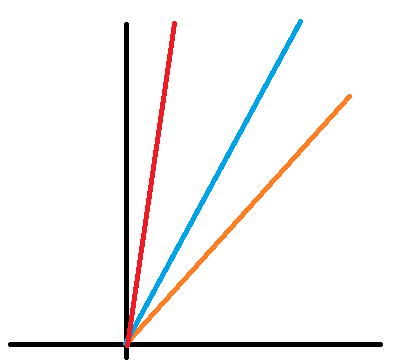-
Posts
5717 -
Joined
-
Days Won
55
Content Type
Profiles
Forums
Events
Everything posted by Genady
-
Here is the diagram. Spatial coordinate is horizontal, temporal is vertical. The light, the ship, and the bullet leave the origin, i.e., the same point in space at the same time. The orange line is the light trajectory, the blue is the ship, and the red is the bullet. (No gravity.)
-
The points in Minkowski spacetime ARE events. The same point cannot be at a different time or spatial distance, in a given reference frame.
-
I don't think it will happen. Certainly not the reduced gravitational pull - the latter requires an accelerated fall, but the ball/piston rather moves in the fluid with a constant speed except momentarily at the very beginning. I think, there is a higher pressure under the piston, a normal pressure above it, and a pressure gradient in the gap where the fluid moves up.
-
I think I can consider, for simplicity, instead of a sinking ball, a piston with a narrow gap being pushed down. This makes it obvious (to me) that there will be an increased pressure under the piston. Why the pressure above the piston will be lowered?
-
Got it. Thank you. I looked, by mistake, on the secondary, upside-down rainbow.
-

Data Reveals Building Block for Life on Saturn Moon
Genady replied to Alex_Krycek's topic in Science News
Phosphorus is used by life. Life is not used by phosphorus. -
This explanation is symmetrical in regard to different colors. Perhaps I miss something. It would explain if the rainbow band were red on the edges and violet in the middle. What makes the violet to appear on the outside edge and the red on the inside edge of the rainbow band?
-
No prob. Cheers.
-
I don't think so. If the fluid motion is caused by the paddle wheel, i.e., by a shaft work, it will not cause a decrease in pressure.
-
Here is how one could measure 30 minutes with the rope.
-
I don't know if it matters here, but generally mathematical objects can be considered in a variety of perspectives. For example, a complex number can be considered as built of real and imaginary parts or of phase and magnitude.
-
Sorry, I've tried but failed to understand the analogy. Thus, don't know what to say.
-
You are right. Very good analysis. +1
-
Thanks. I knew about FSA and PDA, but not about LBA. Of course, they are weaker than TM. If the expansion of the universe slowed, the observable universe would grow with time. In this case, it's not clear if it were bounded. However, with the accelerated expansion, the observable universe actually shrinks. In this case, it is bounded for certain. I understood the OP question as asking if AI is stronger than TM. It seems that we agree on the answer, no, it is not.
-
I am sure that the boat will not rise. Because if it rises, its weight is not balanced by the decreased buoyancy, and it goes down. I cannot tell how the internal forces will redistribute to balance each other, but they will. BTW, you might be interested in this discussion, which is somewhat related: https://www.scienceforums.net/topic/128670-buoyant-force/?do=findComment&comment=1227608 Feel free to skip unrelated comments in that thread.
-
I am reasonably clear about what you mean saying "exist", i.e., the mathematical existence. However, I still don't know what "end" means. For example, number 3 exists. Does it "end"?
-
I think that because you calculate for the solar day, i.e., 24 hours, you need to add the annual movement of the Sun. OTOH, if you calculate for a sidereal day, which is 23 h 56 minutes, you get directly 360/(23h56min) = 15.041.
-
Sublunar point.
-
Yes, I see now that your question is different. You're right then, the distance to the Moon does not matter. However, you can add the angles only if they are aligned, which they generally are not. Also, the Earth circumference is only important if the point is on the equator, which it generally is not.
-
The other comments in that thread show the complications in real situation. The answer depends where on Earth is the point above which the Moon is in zenith. No, these calculations are incorrect. The Moon's projection on the Earth surface doesn't move 14.451 degrees per hour. You need to compare linear velocities rather than the angular ones.
-
This question is the same as to ask, what is the speed of the Moon's shadow on the Earth's surface. This has been discussed here: https://www.scienceforums.net/topic/131698-moon-shadow/ The simple case answer, on the equator, with a back-of-the-envelope calculation was: (https://www.scienceforums.net/topic/131698-moon-shadow/?do=findComment&comment=1240426) The Earth spins from West to East making a full circle in 1 day. The Moon rotates around the Earth from West to East making a full circle in 30 days. OTOH, the radius of the Moon's circle is about 300000 km while the Earth's radius is about 6000 km. This makes the Moon's circle 50 times longer. The Moon makes 50 times longer way in 30 times longer time, i.e., it moves from West to East 50/30 times faster than the Earth surface. Thus, its shadow should move to the East faster than the Earth surface does, hence its shadow on the Earth surface moves to the East.
-
1. What does happen on the other side of the wheel? 2. Consider the following situation. Assume that the fluid inside the boat is sealed. Heat it up. The pressure inside the boat will rise. Will the boat sink?
-
Perhaps a better title would be, a rope-timer.


